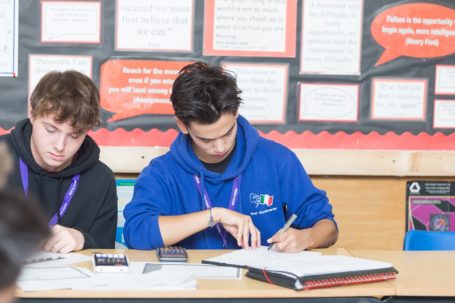In addition to the work studied for A Level on Proof, students are now expected to build proofs using mathematical induction and contexts could include sums of series, divisibility, and powers of matrices.
AS Level Further Mathematics Year 12 & 13
Year 12 & 13 AS Level Further Mathematics Course Modules
Complex Numbers
Complex numbers is the study of real and imaginary numbers. Students will be expected to use and interpret Argand Diagrams, convert between the Cartesian form and the modulus-argument form of a complex number, multiply, and divide complex numbers in modulus-argument form and construct and interpret simple loci in the Argand diagram. They will also be required to solve quadratic, cubic, and quartic equations with real coefficients with complex roots.
Matrices
Students will use matrices to represent linear transformations and successive transformations in 2D and for single transformations in 3D. They will also understand and use singular and non-singular matrices, properties of inverse matrices and calculate and use the inverse of non-singular 2 x 2 and 3 x 3 matrices. They will also be asked to solve 3 linear simultaneous equations and interpret geometrically, the solution or failure of a solution, of these equations.
Further Algebra and Functions
This module builds on the work completed at A Level and introduces new concepts such as the link between the roots of polynomials and understand and use the formulae for the sums of integers, squares and cubes and use these to sum other series.
Further Calculus
This module looks at Volumes of Revolution.
Further Vectors
Students will study Vectors in 3D and use the scalar product.
Momentum and Impulse
Topics studied include conservation of momentum.
Work, Energy and Power
Topics studied include Kinetic and Potential Energy, Work, and Power, the work-energy principle, and the principle of conservation of mechanical energy.
Elastic Collisions in 1 Dimension
This topic looks at: – Direct impact of elastic spheres, Newton’s law of restitution, loss of KE (Kinetic Energy) due to impact, successive direct impacts of spheres and/or a sphere with a smooth plane surface
Algorithms and Graph Theory
This module is the introduction to the general idea of algorithms, sorting and basic graph theory, including the necessary language and skills to determine if a graph is Eulean or semi-Eulerian.
Algorithms on Graphs
This module is an introduction to Spanning Trees, Prim, Kruskal and Dijkstra’s algorithms. We will also look at basic route inspection problems.
Critical Path Analysis
Students will construct, represent, and interpret a precedence (activity) network using activity-on-arc, determine earliest and latest start and finish times for an activity network, identify critical activities, critical paths and the float time of non-critical activities and refine models and understand the implications of possible changes in the context of critical path analysis. They will also be introduced to Gantt charts.
Linear Programming
Students will formulate constrained optimisation problems and solve these via graphical methods.




